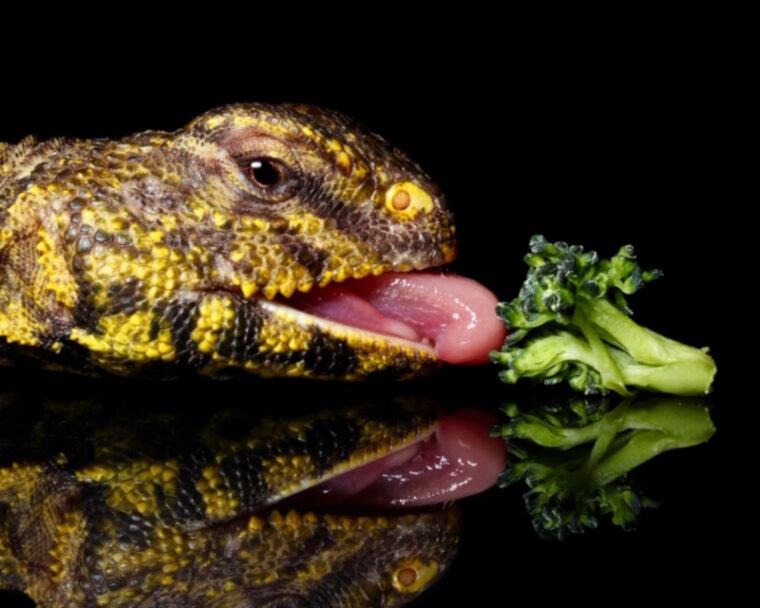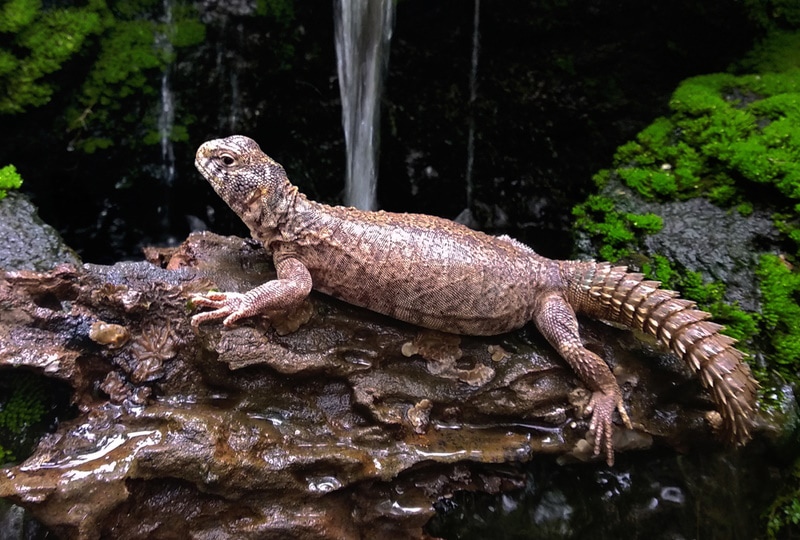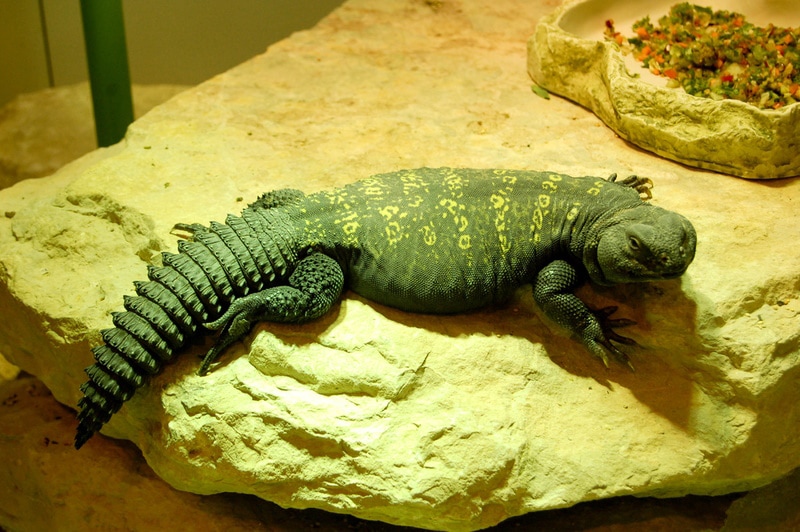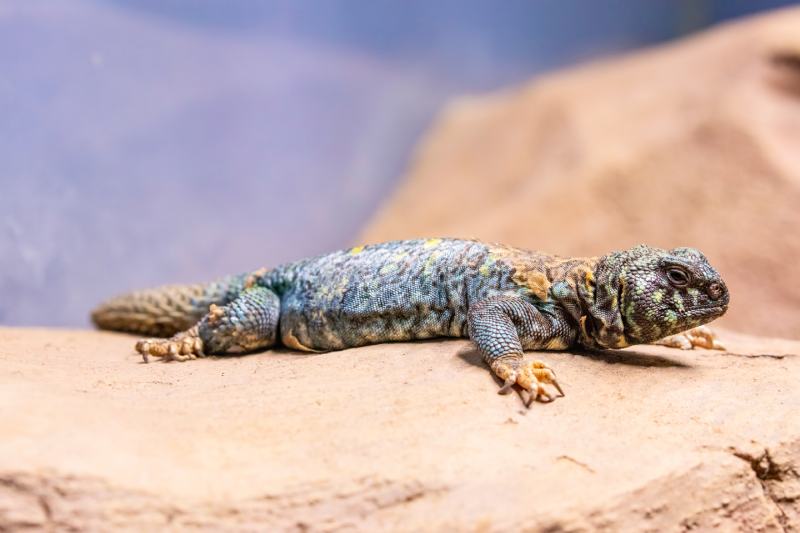
Click to Skip Ahead
As a wildlife enthusiast, there’s nothing more captivating than observing the unique eating habits of different species. Maybe that sounds geeky, but observing nature is endlessly fascinating, even if it’s in your pets! One such fascinating reptile is the Uromastyx lizard, known for its herbivorous diet and specialized digestive mechanisms.
In this informative guide, we will explore the eating habits of Uromastyx lizards, both in the wild and under human care. We will delve into their dietary preferences, feeding schedule, digestive mechanisms, special dietary considerations, and tips for ensuring their optimal health.
Uromastyx Diet in the Wild
Uromastyx lizards are native to the Arabian Peninsula, Northern Africa, and parts of Southwest Asia. In their natural habitats, they often feed on low growing vegetation such as grasses, herbs, cacti, and succulent foliage. They also enjoy a varied diet consisting of fruits, flowers, leaves, stems and, occasionally, insects. In some cases, they will also consume small amounts of animal matter such as bird eggs, lizards, and small rodents.

Uromastyx Diet Under Human Care
Uromastyx are able to eat a variety of healthy foods that are common staples in most home. The diet should consist mainly of vegetables and herbs, supplemented with small amounts of fruits, flowers, and leafy greens. Additionally, some Uromastyx owners will also offer mealworms or wax worms as an occasional treat.
A Guide to Feeding Uromastyx Lizards
Foods to Feed a Uromastyx

Foods to Avoid in Large Amounts
Frequency
Just like us humans, Uromastyx lizards benefit from regular meals. To keep your scaly friend in optimal health, feed your young Uromastyx twice a day – once in the morning and again in the evening. This routine ensures they have a steady supply of nutrients throughout the day, helping them stay active and healthy. Older Uromastyx can be fed less often.
Quantity
When it comes to feeding your Uromastyx, size does matter! A good rule of thumb is to provide an amount of food that is roughly equal to the size of your lizard’s head. Overfeeding can lead to health problems such as obesity and digestive issues, so it’s always better to err on the side of caution. Remember, it’s not just about the quantity but also the quality of food that counts!
Duration
Uromastyx lizards are quick eaters. They typically finish their meal within 15–30 minutes. It’s essential to remove any uneaten food after this time period to maintain cleanliness and prevent the growth of bacteria in their habitat. Regular cleaning also helps to avoid attracting pests and keeps your Uromastyx’s home a safe and comfortable place.

Digestive System
Understanding the Uromastyx lizard’s digestive system is essential to ensure their optimal health and prevent complications. Here’s an overview of their unique digestive system:
Hindgut Fermentation
Uromastyx lizards possess a specialized hindgut that serves as a fermentation chamber. It allows them to break down complex plant fibers and extract maximum nutrition from their diet, similar to a horse.
Calcium Metabolism
These lizards require ample calcium for proper bone development and overall health. Supplement their diet with calcium-rich foods such as calcium dusted on greens or calcium-rich reptile-specific supplements.
Water Consumption
Uromastyx lizards have evolved to obtain most of their water requirements from the vegetation they consume. However, they still benefit from regular access to fresh water for hydration purposes.
Special Dietary Considerations
To ensure the optimal health of Uromastyx lizards, consider the following dietary considerations:
UVB Lighting
Provide appropriate UVB lighting to facilitate vitamin D3 synthesis, which aids in calcium absorption. This is crucial for maintaining healthy bones and preventing metabolic bone disease.

Dental Health
Uromastyx lizards have specialized dental structures adapted for grinding plant material. To promote dental health, offer a variety of textured foods, including tough greens and occasional fibrous treats like edible cacti.
Gut Loading and Supplementation
If utilizing feeder insects as an occasional treat, make sure to gut load them with nutritious vegetables for at least 24 hours before offering them to the lizard.
Supplementation
In addition to a well-balanced diet, Uromastyx lizards may benefit from vitamin and mineral supplements. Calcium and vitamin D3 are particularly important for their bone health. Consult with a reptile veterinarian or herpetologist to determine the appropriate supplementation regimen for your Uromastyx lizard.
Temperature and Humidity
Uromastyx lizards are adapted to arid environments and require specific temperature and humidity conditions for proper digestion and overall health. Ensure that their enclosure provides a temperature gradient, with a basking spot around 100-110°F (38-43°C) and a cooler side around 80–90°F (27–32°C). Maintain a relative humidity level of around 30–40%.
Preparing and Serving Food
To ensure the optimal health and nutrition of Uromastyx lizards, it is important to properly prepare and serve their food:
Additional Tips for Optimal Uromastyx Health
To promote the overall well-being of Uromastyx lizards, consider the following tips:

Conclusion
Understanding the eating habits of Uromastyx lizards is crucial for their optimal health and well-being, whether in the wild or under human care. By providing a balanced and varied diet, replicating their natural feeding behaviors, and considering their specialized digestive mechanisms, you can ensure a long and healthy life for these fascinating reptiles.
Featured Image Credit: Sean McVey, Shutterstock










